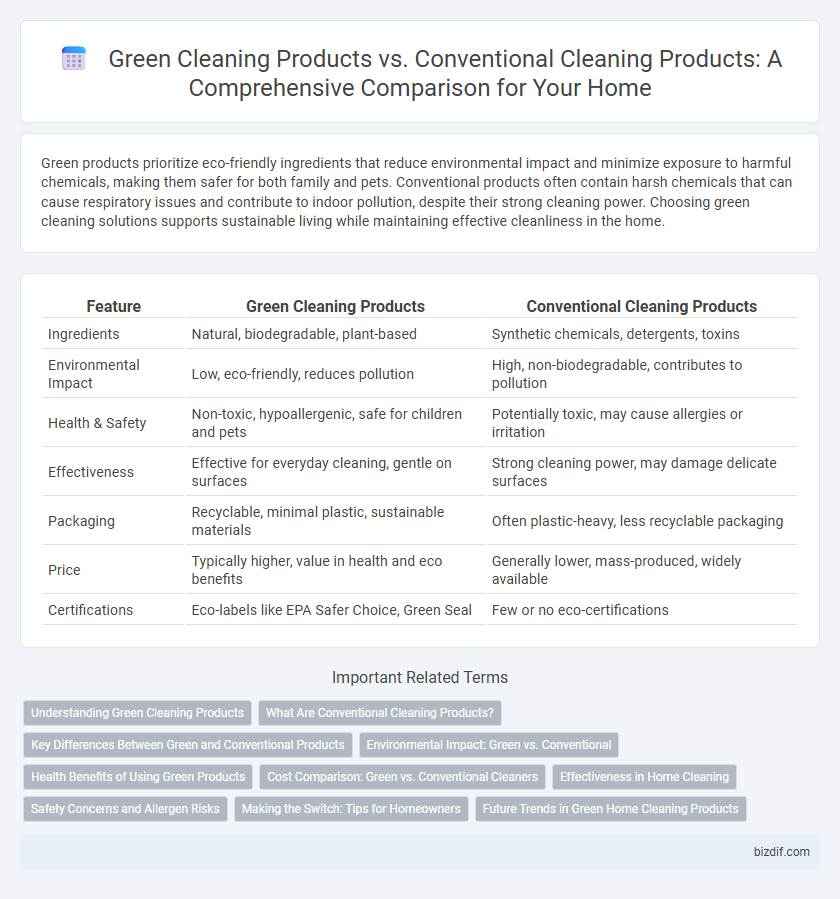Green products prioritize eco-friendly ingredients that reduce environmental impact and minimize exposure to harmful chemicals, making them safer for both family and pets. Conventional products often contain harsh chemicals that can cause respiratory issues and contribute to indoor pollution, despite their strong cleaning power. Choosing green cleaning solutions supports sustainable living while maintaining effective cleanliness in the home.
Table of Comparison
| Feature | Green Cleaning Products | Conventional Cleaning Products |
|---|---|---|
| Ingredients | Natural, biodegradable, plant-based | Synthetic chemicals, detergents, toxins |
| Environmental Impact | Low, eco-friendly, reduces pollution | High, non-biodegradable, contributes to pollution |
| Health & Safety | Non-toxic, hypoallergenic, safe for children and pets | Potentially toxic, may cause allergies or irritation |
| Effectiveness | Effective for everyday cleaning, gentle on surfaces | Strong cleaning power, may damage delicate surfaces |
| Packaging | Recyclable, minimal plastic, sustainable materials | Often plastic-heavy, less recyclable packaging |
| Price | Typically higher, value in health and eco benefits | Generally lower, mass-produced, widely available |
| Certifications | Eco-labels like EPA Safer Choice, Green Seal | Few or no eco-certifications |
Understanding Green Cleaning Products
Green cleaning products are formulated with natural, non-toxic ingredients that minimize environmental impact and reduce exposure to harmful chemicals often found in conventional cleaning products. These eco-friendly alternatives typically contain biodegradable substances, plant-based surfactants, and fewer synthetic fragrances or dyes, enhancing indoor air quality while maintaining effective cleaning power. Understanding the differences empowers consumers to make safer, sustainable choices that protect both health and the planet during home cleaning.
What Are Conventional Cleaning Products?
Conventional cleaning products typically contain synthetic chemicals such as ammonia, chlorine bleach, and phthalates, which can pose health risks and contribute to indoor air pollution. These products often rely on petrochemical-derived ingredients that may cause skin irritation, respiratory issues, and environmental harm due to their non-biodegradable nature. Despite their strong cleaning power, conventional cleaners can have long-term impacts on both human health and ecological systems.
Key Differences Between Green and Conventional Products
Green home cleaning products use biodegradable ingredients and plant-based chemicals that reduce environmental impact and limit exposure to harsh toxins, unlike conventional products that often contain synthetic chemicals, phosphates, and volatile organic compounds (VOCs), which can harm indoor air quality and contribute to pollution. These eco-friendly alternatives promote sustainability by using renewable resources and minimal packaging, whereas conventional products typically rely on petrochemical-derived substances and non-recyclable containers. In terms of health benefits, green cleaning agents are less likely to trigger allergies or respiratory issues, making them safer for households with children or pets.
Environmental Impact: Green vs. Conventional
Green cleaning products significantly reduce environmental impact by using biodegradable ingredients that break down naturally without polluting water sources, unlike conventional products often containing harmful chemicals such as phosphates and synthetic fragrances that contribute to water contamination and ecosystem disruption. The production of green products typically involves sustainable sourcing and fewer toxic emissions, while conventional products rely on petrochemical processes that increase carbon footprint and hazardous waste. Choosing green alternatives supports reduced air and water pollution, minimizes waste in landfills, and promotes healthier ecosystems overall.
Health Benefits of Using Green Products
Green cleaning products reduce exposure to harmful chemicals commonly found in conventional cleaners, minimizing respiratory issues and allergic reactions. These products often contain natural ingredients like plant-based surfactants and essential oils that are less likely to irritate skin and eyes. Using green products promotes a healthier indoor environment by reducing volatile organic compounds (VOCs) that can contribute to headaches and long-term health problems.
Cost Comparison: Green vs. Conventional Cleaners
Green cleaning products often have a higher upfront cost compared to conventional cleaners but offer long-term savings by reducing health risks and environmental damage. Conventional products tend to be cheaper initially but may incur hidden expenses such as respiratory issues, allergies, and environmental cleanup costs. Consumers choosing green cleaners benefit from safer indoor air quality and reduced ecological impact, offsetting the price difference over time.
Effectiveness in Home Cleaning
Green cleaning products often leverage biodegradable ingredients such as plant-based surfactants and natural enzymes to remove dirt and grime effectively, reducing chemical residues and indoor air pollution. Conventional cleaning products typically rely on synthetic chemicals and harsher agents like bleach and ammonia, providing rapid stain removal and germ elimination but posing potential health risks. Comparative studies show green products can match conventional cleaners in effectiveness for routine home cleaning while offering a safer, eco-friendly alternative for sensitive households.
Safety Concerns and Allergen Risks
Green cleaning products contain natural ingredients that reduce exposure to harsh chemicals, lowering the risk of skin irritation and respiratory issues often linked to conventional products. Conventional cleaning products frequently include synthetic fragrances and volatile organic compounds (VOCs), which can trigger allergies and asthma symptoms in sensitive individuals. Opting for eco-friendly alternatives minimizes harmful allergen risks while promoting a safer indoor environment for families, especially children and pets.
Making the Switch: Tips for Homeowners
Switching to green cleaning products reduces toxic chemical exposure and supports environmental sustainability without sacrificing effectiveness. Homeowners should start by identifying eco-friendly brands certified by reputable organizations such as EPA Safer Choice or Green Seal. Gradually replacing conventional products room by room and testing homemade solutions like vinegar and baking soda ensures a smooth transition while maintaining a clean, healthy home environment.
Future Trends in Green Home Cleaning Products
Future trends in green home cleaning products emphasize biodegradable ingredients, reducing environmental impact while maintaining efficacy. Innovations include plant-based enzymes and essential oil formulations that offer antimicrobial properties without harsh chemicals. Increasing consumer demand and stricter regulations drive manufacturers to develop sustainable, non-toxic alternatives that are safe for both families and the planet.
Green Products vs Conventional Products Infographic

 bizdif.com
bizdif.com